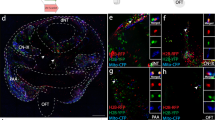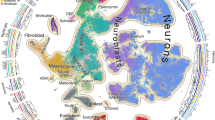Abstract
The hindbrain roof plate and choroid plexus are essential organizing centers for inducing dorsal neuron fates and sustaining neuron function. To map the formation of these structures, we developed a broadly applicable, high resolution, recombinase-based method for mapping the fate of cells originating from coordinates defined by intersecting combinations of expressed genes. Using this method, we show that distinct regions of hindbrain roof plate originate from discrete subdomains of rhombencephalic neuroectoderm expressing Wnt1; that choroid plexus, a secretory epithelium important for patterning later-formed hindbrain structures and maintaining neuron function1, derives from the same embryonic primordium as the hindbrain roof plate; and that, unlike the floor plate2,3, these dorsal organizing centers develop in a patterned, segmental manner, built from lineage-restricted compartments. Our data suggest that the roof plate and choroid plexus may be formed of functional units that are capable of differentially organizing the generation of distinct neuronal cell types at different axial levels.
This is a preview of subscription content, access via your institution
Access options
Subscribe to this journal
Receive 12 print issues and online access
$209.00 per year
only $17.42 per issue
Buy this article
- Purchase on Springer Link
- Instant access to full article PDF
Prices may be subject to local taxes which are calculated during checkout





Similar content being viewed by others
References
Yamamoto, M., McCaffery, P. & Drager, U.C. Influence of the choroid plexus on cerebellar development: analysis of retinoic acid synthesis. Brain Res. Dev. Brain Res. 93, 182–190 (1996).
Fraser, S., Keynes, R. & Lumsden, A. Segmentation in the chick embryo hindbrain is defined by cell lineage restrictions. Nature 344, 431–435 (1990).
Lumsden, A. & Keynes, R. Segmental patterns of neuronal development in the chick hindbrain. Nature 337, 424–428 (1989).
Manzanares, M., Trainor, P.A., Ariza-McNaughton, L., Nonchev, S. & Krumlauf, R. Dorsal patterning defects in the hindbrain, roof plate and skeleton in the dreher (drJ) mouse mutant. Mech. Dev. 94, 147–156 (2000).
Millonig, J.H., Millen, K.J. & Hatten, M.E. The mouse Dreher gene Lmx1a controls formation of the roof plate in the vertebrate CNS. Nature 403, 764–769 (2000).
Lee, K.J., Dietrich, P. & Jessell, T.M. Genetic ablation reveals that the roof plate is essential for dorsal interneuron specification. Nature 403, 734–740 (2000).
Zinyk, D., Mercer, E.H., Harris, E., Anderson, D.J. & Joyner, A.L. Fate mapping of the mouse midbrain-hindbrain constriction using a site-specific recombination system. Curr. Biol. 8, 665–668 (1998).
Dymecki, S. & Tomasiewicz, H. Using Flp recombinase to characterize expansion of Wnt1-expressing neural progenitors in the mouse. Dev. Biol. 201, 57–65 (1998).
Rodriguez, C.I. & Dymecki, S.M. Origin of the precerebellar system. Neuron 27, 475–486 (2000).
Lumsden, A. & Krumlauf, R. Patterning the vertebrate neuraxis. Science 274, 1109–1115 (1996).
Zambrowicz, B.P. et al. Disruption of overlapping transcripts in the ROSA βgeo 26 gene trap strain leads to widespread expression of β-galactosidase in mouse embryos and hematopoietic cells. Proc. Natl. Acad. Sci. USA 94, 3789–3794 (1997).
Jiang, W. & Hunter, T. Analysis of cell-cycle profiles in transfected cells using a membrane-targeted GFP. Biotechniques 24, 349–354 (1998).
Meyers, E.N., Lewandoski, M. & Martin, G.R. An Fgf8 mutant allelic series generated by Cre- and Flp-mediated recombination. Nat. Genet. 18, 136–141 (1998).
Farley, F.W., Soriano, P., Steffen, L.S. & Dymecki, S.M. Widespread recombinase expression using FLPeR (flipper) mice. Genesis 28, 106–110 (2000).
Bally-Cuif, L., Alvarado-Mallart, R.M., Darnell, D.K. & Wassef, M. Relationship between Wnt-1 and En-2 expression domains during early development of normal and ectopic met-mesencephalon. Development 115, 999–1009 (1992).
Chai, Y. et al. Fate of the mammalian cranial neural crest during tooth and mandibular morphogenesis. Development 127, 1671–1679 (2000).
Echelard, Y., Vassileva, G. & McMahon, A.P. Cis-acting regulatory sequences governing Wnt-1 expression in the developing mouse CNS. Development 120, 2213–2224 (1994).
Frasch, M., Chen, X. & Lufkin, T. Evolutionary-conserved enhancers direct region-specific expression of the murine Hoxa-1 and Hoxa-2 loci in both mice and Drosophila. Development 121, 957–974 (1995).
Soriano, P. Generalized lacZ expression with ROSA26 Cre reporter strain. Nat. Genet. 21, 70–71 (1999).
Voiculescu, O., Charnay, P. & Schneider-Maunoury, S. Expression pattern of a Krox-20/Cre knock-in allele in the developing hindbrain, bones, and peripheral nervous system. Genesis 26, 123–126 (2000).
Wilkinson, D.G., Bhatt, S., Chavrier, P., Bravo, R. & Charnay, P. Segment-specific expression of a zinc-finger gene in the developing nervous system of the mouse. Nature 337, 461–464 (1989).
Prince, V. & Lumsden, A. Hoxa-2 expression in normal and transposed rhombomeres: independent regulation in the neural tube and neural crest. Development 120, 911–923 (1994).
Altman, J. & Bayer, S. Development of the Cerebellar System: In relation to its evolution, structure, and functions (ed. Petralia, P.) (CRC Press, Boca Raton, 1997).
Wingate, R.J. & Hatten, M.E. The role of the rhombic lip in avian cerebellum development. Development 126, 4395–4404 (1999).
Becker, N. et al. Several receptor tyrosine kinase genes of the Eph family are segmentally expressed in the developing hindbrain. Mech. Dev. 47, 3–17 (1994).
Flenniken, A.M., Gale, N.W., Yancopoulos, G.D. & Wilkinson, D.G. Distinct and overlapping expression patterns of ligands for Eph-related receptor tyrosine kinases during mouse embryogenesis. Dev. Biol. 179, 382–401 (1996).
Bergemann, A.D., Cheng, H.J., Brambilla, R., Klein, R. & Flanagan, J.G. ELF-2, a new member of the Eph ligand family, is segmentally expressed in mouse embryos in the region of the hindbrain and newly forming somites. Mol. Cell. Biol. 15, 4921–499 (1995).
Inoue, T., Chisaka, O., Matsunami, H. & Takeichi, M. Cadherin-6 expression transiently delineates specific rhombomeres, other neural tube subdivisions, and neural crest subpopulations in mouse embryos. Dev. Biol. 183, 183–194 (1997).
Gale, N.W. et al. Elk-L3, a novel transmembrane ligand for the Eph family of receptor tyrosine kinases, expressed in embryonic floor plate, roof plate and hindbrain segments. Oncogene 13, 1343–1352 (1996).
Marin, F. & Puelles, L. Morphological fate of rhombomeres in quail/chick chimeras: a segmental analysis of hindbrain nuclei. Eur. J. Neurosci. 7, 1714–1738 (1995).
Acknowledgements
We thank S. Schneider-Maunoury for the Egr2::cre mouse strain; A. McMahon for plasmids pWEXP2 and pSP72MT34; T. Lufkin for the rhombomere 2–specific enhancer of Hoxa2; S. Thor for sequences encoding eGFPF; G. Martin for the pACTB::cre plasmid; J. Flanagan for plasmids encoding Eph receptors and their ligands; C. Tabin for a plasmid encoding cadherin-6; C. Tabin, C. Branda and A. Farago for critical reading of this manuscript; and S. Blackshaw for useful discussions. Work in the laboratories of S.M.D. and P.S. was supported by grants from the US National Institutes of Health. R.A. was supported by a Wills Foundation postdoctoral fellowship award and is currently supported by Taplin Funds for Discovery.
Author information
Authors and Affiliations
Corresponding author
Ethics declarations
Competing interests
The authors declare no competing financial interests.
Supplementary information
Rights and permissions
About this article
Cite this article
Awatramani, R., Soriano, P., Rodriguez, C. et al. Cryptic boundaries in roof plate and choroid plexus identified by intersectional gene activation. Nat Genet 35, 70–75 (2003). https://doi.org/10.1038/ng1228
Received:
Accepted:
Published:
Issue Date:
DOI: https://doi.org/10.1038/ng1228
This article is cited by
-
A CRISPR toolbox for generating intersectional genetic mouse models for functional, molecular, and anatomical circuit mapping
BMC Biology (2022)
-
Regulation of choroid plexus development and its functions
Cellular and Molecular Life Sciences (2022)
-
Intravital microscopy imaging of kidney injury and regeneration
Renal Replacement Therapy (2021)
-
Dual recombinases-based genetic lineage tracing for stem cell research with enhanced precision
Science China Life Sciences (2021)
-
Cumulative inactivation of Nell-1 in Wnt1 expressing cell lineages results in craniofacial skeletal hypoplasia and postnatal hydrocephalus
Cell Death & Differentiation (2020)



